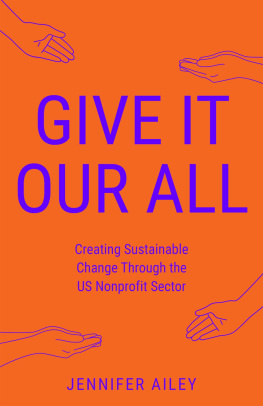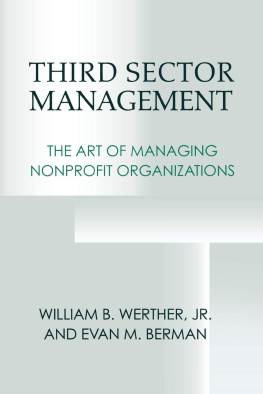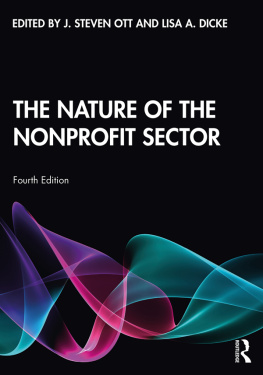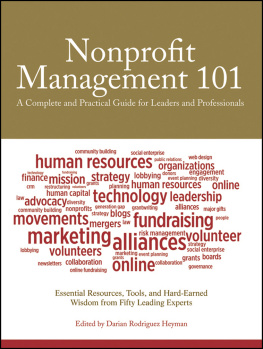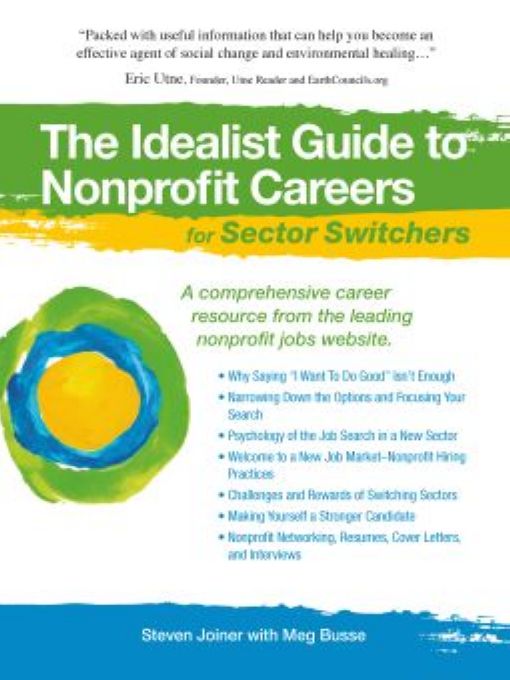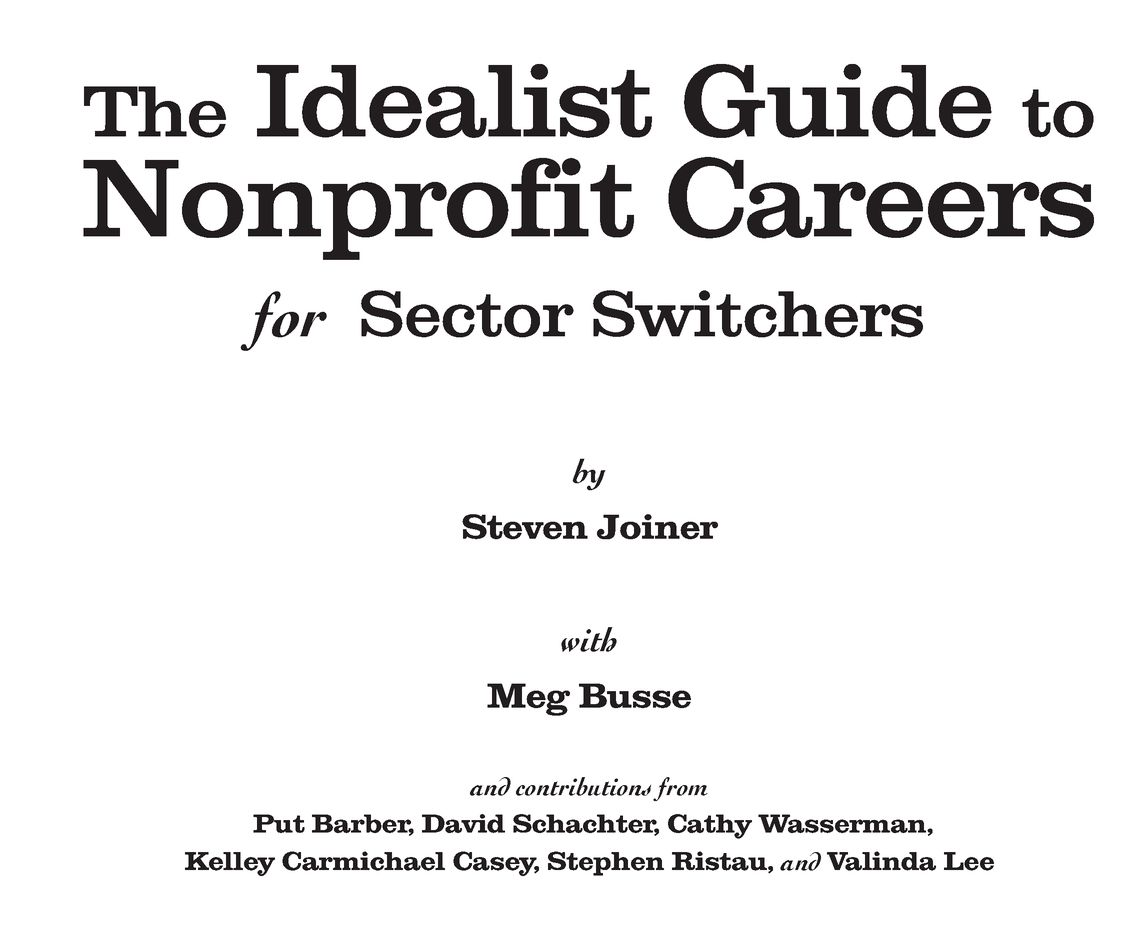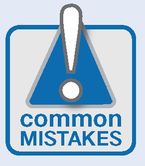Table of Contents
INTRODUCTION
Opening thoughts
Why do you want to work in the nonprofit sector anyway?
In this introduction you will:
Get an overview of the purpose of The Idealist Guide.
Learn about the thematic threads woven through the chapters.
Meet the authors and learn about the organizations behind this book.
Learn about the summary on the last page of each section.
A brave new nonprofit world
Nonprofit. Charity. Nongovernmental organization. Nonprofits have historically been defined by what they are not (profit-making) or by what they give away. These terms can conjure up images of soup kitchens run out of church basements, people collecting signatures on street corners, and organizations of do-gooders striving to compensate for a lack of funds by working long hours and relying on volunteers. Yet this image of the nonprofit sector is far from complete.
In the United States, todays nonprofits make up a vibrant, innovative, multi-trillion dollar sector that is continually evolving and adapting to societys needs and constraints. The list of nonprofits in the United States and in your community will probably surprise you: private universities like Harvard or public ones like Texas A&M; multi-billion dollar area hospitals; international relief organizations like Doctors Without Borders; religious organizations ranging from local congregations to national groups like Focus on the Family or the American Friends Service Committee; organizations spanning the length of the left-right, liberal-conservative political spectrum; and membership organizations like the American Bar Association, the American Civil Liberties Union, and the National Rifle Association. Additionally, the traditionally clear lines delineating nonprofit, for-profit, and government sectors are dissolving into porous borders where corporations are stepping up to be responsible social stewards, government agencies are contracting out much of their work to nonprofits, and nonprofits are becoming more lean and efficient in the face of limited funding and, yes, competition. Given these shifting borders of responsibility and focus, nonprofits are actively looking for entrepreneurial, innovative, and visionary professionals with transferable skills as well as experience in other sectors to take on leadership roles.
Whats in a name?
The language of the workplace is ever changing. From names of new technology to new ways of doing work, our modern workforce has a vocabulary that barely resembles the workforce language of even a decade ago. So it is not surprising that the terminology around how professionals identify themselves is also in a state of flux. More and more, terms like sector switcher, mid-career professional, encore professional, bridger, transitioner, nonlinear careerist, and emerging practitioner are used to describe the same workplace phenomenon: todays professionals are mobile and rarely locked into one career for the entirety of their work life. So, feel free to use whatever terms you feel comfortable with. We will do the same throughout this book.
Professionals with any number of years of work experience who are interested in finding work with meaning and a way to give back to society while also earning a paycheck can find a plethora of opportunities in the nonprofit sector. This book will help you understand the vibrancy and breadth of the sector, as well as assist you in your journey along a meaningful career path to nonprofit work. Nonprofits are no longer a place where you work for a few years after college or in transition between real jobs. Today, nonprofits are a place where you can lead a challenging and fulfilling lifelong career.
As you explore nonprofit opportunities with this book, set aside your notions of what a nonprofit is and prepare to discover a sector that will, we think, surprise you.
Advantages and disadvantages of working in nonprofits
There is no question that nonprofits tend to attract people with certain shared values. A typical profile of nonprofit professionals would include their desire to wed their passion for the issues that inspire them with their paid work; a focus on the bottom line of positive social change; and a real interest in making a tangible difference in the communities they serve. This merging of passion, purpose, and paycheck can be a strong pull for people seeking to find meaning in their daily lives.
This genuine appeal of meaningful work, combined with the traditional (and still often accurate) perception of nonprofits as more laid back and less formal, attracts many people to the sector. In recent interviews with nonprofit human resource professionals conducted by Idealist.org, several respondents spoke of individuals simply wanting to work in a nonprofit environment regardless of the organizations mission or structure, or the role that they would play. In other words, professionals are drawn to the nonprofit sector by a variety of perceived advantages that the work holds over careers in the private/for-profit or public/government sectors. Yet, while many of these advantages do exist, one must be careful to not blissfully overlook the challenges of nonprofit work.
The advantages
There are many reasons why nonprofit work is appealing. Some of the generalizations of nonprofitslaid back, friendly, mission-drivenare based in a reality that appeals to various types of personalities. Some advantages of nonprofit work can include:
The ability to do
meaningful work that focuses less on results benefiting the employer and more on creating positive change in the community at large. What that positive change entails is the prerogative of the nonprofit organization. A nonprofit career also allows you do to the kind of work that you might otherwise only be able to do on your own (unpaid) time.
SURELY THERE ISNT A PLACE IN NONPROFITS FORMYKIND OF WORK!
The nonprofit sector has opportunities for almost every type of profession. If you are an accountant, marketing specialist, actor, lawyer, baker, caterer, teacher, coach, carpenter, computer technician, or a specialist in any of a myriad of other non-traditional nonprofit professions, there is a place in the sector for your skills and talents.
What are these text boxes all about?
For an explanation of the sidebars and threads that appear throughout this book, please see pages 9-10.
More hands-on opportunities that allow you to directly experience the positive outcomes of your work.
A greater flexibility in how the work is carried out, how benchmarks are met, and which alternative strategies to employ in order to accomplish the mission of an organization.
A more casual work environment. This can include a more relaxed dress code, flexible schedules, and an open physical work environment.
The opportunity to wear several hats. Since many nonprofits are understaffed, nonprofit professionals have the chance to perform many different job functions and move outside of a strict set of job responsibilities. This allows for a greater opportunity to learn new skills and further develop preexisting abilities on the job.


